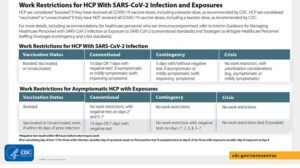Due to the increased transmissibility of Omicron and concerns abouts potential impacts on the healthcare system, CDC has updated recommendations to assist with maintaining appropriate healthcare personnel (HCP) staffing in healthcare facilities and providing a safe work and care environment.
The CDC’s mitigation strategies offer a continuum of options to address healthcare staffing shortages and are meant to be implemented sequentially. If conventional strategies cannot be sustained during a surge, facilities can implement contingency strategies, and then crisis strategies, in an incremental manner. The continuum approach is aimed at shortening the duration of work restrictions when necessary. CDC also recommends the following strategies through collaboration with staff leadership, human resources, and occupational health services:
- Adjust staff schedules
- Hire additional healthcare personnel
- Rotate personnel to positions that support patient care
- Modifications to work restrictions to maintain adequate staffing and minimizing the risk of COVID-19 transmission
IHCA recommends that you review the updated CDC guidance in detail. The following summarizes the guidance regarding conventional, contingency, and crisis strategies categorized by Asymptomatic HCP with Higher-risk exposure and HCPs with COVID-19 infection.
Asymptomatic Healthcare Personnel with Higher-risk exposure:
- Personnel who have received COVID-19 vaccine and booster do not need to be restricted from work if they have had a higher risk exposure and do not have symptoms.
- Follow recommended infection prevention and control practices (distancing when possible, earing appropriate PPE, hand hygiene)
- Isolate immediately if symptoms develop
- COVID-19 testing per CDC guidance if under conventional strategies. Under contingency or crisis strategies, testing is not required, and the duration of quarantine may be shortened.
- Personnel who have not received all COVID-19 vaccine and booster doses and under conventional conditions, asymptomatic, and who have had a higher-risk exposure can return to the workplace after day ten without testing.
- Under contingency conditions, personnel can continue to work using a “test-to-stay” strategy.
- Under crisis conditions, personnel can continue to work without testing if they remain asymptomatic.
- Use of well-fitting respiratory source control for exposed healthcare personnel while in the facility.
Healthcare Personnel with COVID-19 infection:
In general, asymptomatic HCP who have had a higher-risk exposure do not require work restriction if they have received all COVID-19 vaccine doses, including booster dose, as recommended by CDC and do not develop symptoms or test positive for SARS-CoV-2. The duration of protection offered by booster doses of vaccine and their effect on emerging variants are not clear; additional updates will be provided as more information becomes available.
- Under conventional conditions, healthcare facilities can allow asymptomatic or mildly symptomatic (with improving symptoms) healthcare personnel with SARS-CoV-2 infection, regardless of vaccination status, to return to work after seven days and a negative test in accordance with CDC guidance.
- For healthcare personnel who were symptomatic, fever should have resolved without medications, as detailed in Return-to-Work Criteria.
- Under contingency conditions, healthcare personnel with SARS-CoV-2 infection can return to work at five days with or without negative viral test, if asymptomatic or mild symptoms that are improving and fever free for twenty-four (24) hours without fever-reducing medications.
- Under crisis conditions, such personnel can remain at work or can return to work at less than five days, if asymptomatic or mildly symptomatic, as a last resort, without testing. These healthcare personnel should wear a respirator or well-fitting facemask even when they are in non-patient care areas. Facilities should consider assigning these healthcare personnel to duties that do not include care of immunocompromised patients.
- When using the conventional strategy, work restrictions for healthcare personnel should not be shortened under certain circumstances including but not limited to personnel who are moderately to severely immunocompromised. Also, in the event of ongoing transmission within a facility that is not controlled with initial interventions, strong consideration should be given to using stringent work restriction for healthcare personnel with higher-risk exposures.
CDC also clarified calculation of days for isolation periods as follows:
- To calculate your 10 full-day isolation period, day 0 is your first day of symptoms. Day 1 is the first full day afteryour symptoms developed.
- If you test positive for COVID-19 and neverdevelop symptoms, day 0 is the day of your positive viral test (based on the date you were tested) and day 1 is the first full day after your positive test. If you develop symptoms after testing positive, your 10-day isolation period must start over. Day 0 is your first day of symptoms. Day 1 is the first full day after your symptoms developed.
Follow the chart below to determine work restrictions for healthcare workers with COVID-19 infection and exposures.

The recommendations for healthcare personnel are to do the following:
- Get all doses of COVID-19 vaccines including boosters’ doses as recommended by the CDC including the influenza vaccine to protect yourself and other.
About the Author



